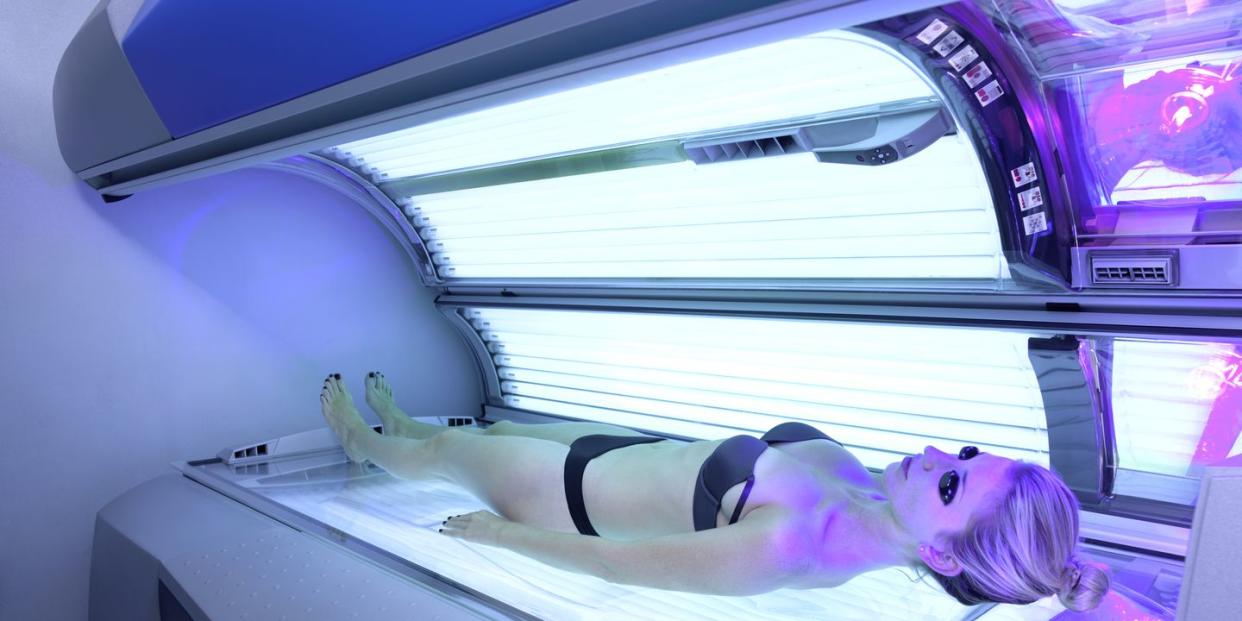This Woman's Tanning Bed Addiction Left Her With a Gaping Hole on Her Face

A 2017 study found that tanning bed addiction is real, and can lead to skin cancer, depressive symptoms and an obsession with physical appearance, among other things. This is really scary because according to the Skin Cancer Foundation, people who first use a tanning bed before age 35 increase their risk for melanoma-the most deadly form of skin cancer-by 75 percent.
Carrie Doles, a woman based in Illinois, became a statistic after her years-long tanning addiction led to a skin cancer diagnosis. The 34-year-old mother of two now lives with a gaping hole on her face, and is sharing her story with the world in hopes of educating people about the potential health implications of getting a tan.
“It became an addiction. If I missed a day I would become depressed,” she told WFLD, a local Chicago news station. Dole, who started indoor tanning during her college years, would go to the salon with her friends-sometimes nearly every single day. “It was euphoric. I guess you could say I was on a high after I had my tan. We all did it. We would all go together.”
However, after college she started noticing small spots on her leg, and was informed by her doctor that she had basal cell carcinoma. She had the skin cancer removed and was instructed by her doctor to stop using tanning beds. “I didn’t heed his warning,” she admitted. “I didn’t think it was that big of a deal so I continued to tan after that.”
A few years later, at the age of 26, she noticed a small spot on her face but opted to put off seeing a doctor. “Kind of just let it go, didn't think anything of it, and for a while, it was there,” she said. When she went to see her doctor right before her wedding she learned that the small lesion was cancer-and it had rapidly spread under her skin. She had surgery to remove it, but it left a noticeable hole. “I heard them cutting into my skin. When they finally said that the cancer cells were removed, I was left with a huge hole in the side of my face,” she revealed.
Her story doesn’t end there. Over the next few years, she got cancer a third time and expects it will continue to recur over the years. “I'm more than likely going to have another couple bouts of skin cancer. Now that I've had it, my risks are very high,” Doles said.
She now avoids tanning beds altogether, wears sunscreen daily, and stays out of the sun. “It’s not worth it. It’s not worth dying over having a tan,” she said.
What is skin cancer?
Skin cancer is the most common type of cancer in the U.S. with about one in five Americans developing a form of it by the age of 70. Different types include melanoma (the rarest and most deadliest form), actinic keratosis, basal cell carcinoma (the most common form), merkel cell carcinoma, and squamous cell carcinoma.
What are the risk factors of skin cancer?
While people of all ages can get skin cancer, it is more common in those older than 50. People with fair skin or red hair, those who live at a high altitude, are exposed to radiation, have lots of moles on their body, have a family history of skin cancer, or who have spent a lot of time in the sun or in tanning beds are also at increased risk.
What are the symptoms of skin cancer?
The most common symptom of skin cancer are asymmetrical-looking moles in various places on your body. They usually appear in places where your skin gets the most exposure to the sun, including your face, ears, scalp, lips, neck, chest, hands, legs, and arms. It can also show up in other areas-even your groin or in between your toes.
How is skin cancer diagnosed?
If you notice any discoloration or unusual moles on your skin, you should contact your dermatologist immediately. They will conduct a skin exam and determine whether your changes could be cancerous. If they are suspicious, they will likely do a biopsy (remove a piece of skin) and have it examined in a lab.
How is skin cancer treated?
Treatment for skin cancer varies to due to the type, severity, size and location of the tumor, as well as your overall health. However, common treatments include:
Surgery
Moh's micrographic surgery
Radiation
Chemotherapy
Photodynamic therapy
Biologic therapies
Targeted therapies
Creams
Laser therapy
How do you prevent skin cancer?
Make sure to wear broad-spectrum sunscreen with a minimum SPF 30 daily-even during the winter, when it's cloudy outside, or if you don't plan on spending much time outside. If you're outside, attempt to stay in the shade when you can. The sun's rays are strongest between 10 a.m. and 2 p.m., so it’s better to keep exposure during those hours at a minimum. Wear protective clothing, including a wide-brimmed hat if it's a really sunny day or if you plan to be outside for a long period of time. Never, ever use tanning beds. Lastly, get your skin checked by a professional once a year and check your own skin monthly: Learn how to do one here.
('You Might Also Like',)

